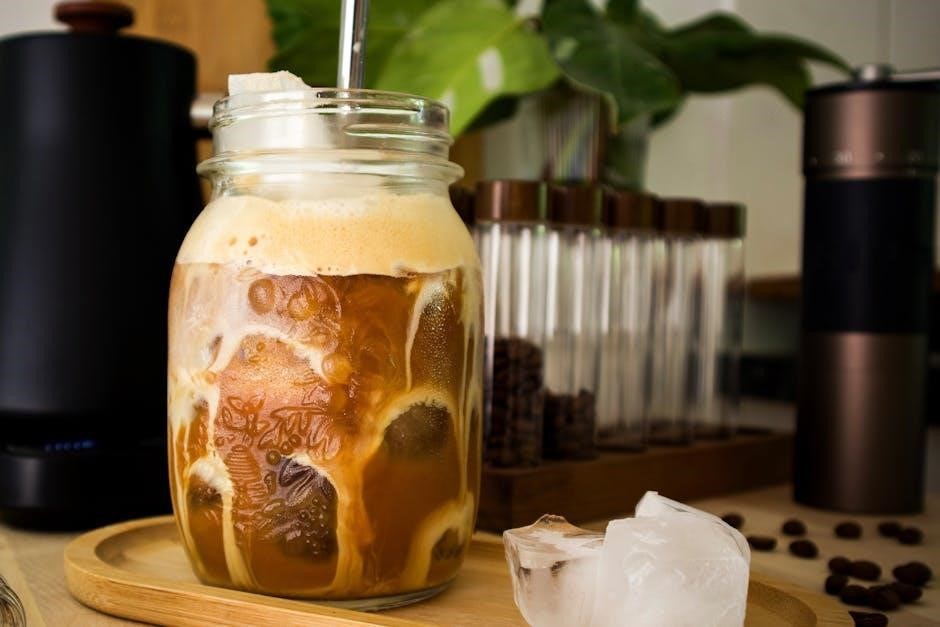Espresso is a concentrated coffee drink with a rich, bold flavor, made by forcing pressurized hot water through finely ground coffee beans, serving as the base for various beverages.
What is Espresso?
Espresso is a concentrated coffee drink produced by forcing pressurized hot water through finely ground coffee beans. It is characterized by its thick, creamy texture, known as “crema,” and a robust, intense flavor. Typically served in small quantities, around 1 ounce, espresso is the foundation for many popular coffee drinks like lattes and cappuccinos. The unique brewing method involves high pressure, which extracts oils and solids from the beans, creating a distinct aroma and taste; Espresso is often enjoyed on its own by coffee enthusiasts who appreciate its bold, rich profile.
A Brief History of Espresso
Espresso originated in Italy in the late 19th century, with Angelo Moriondo patenting the first espresso-like machine in 1884. Luigi Bezzera improved upon this design, creating a machine that forced pressurized hot water through coffee grounds, laying the groundwork for modern espresso. In 1901, Desiderio Pavoni developed the first practical espresso machine, which gained popularity in cafes across Italy. By the mid-20th century, espresso had spread globally, becoming a cultural symbol of coffee tradition. Its evolution continued with advancements in machine technology, leading to the high-quality espresso we enjoy today, with its rich flavor and iconic crema.
The Key Components of a Perfect Espresso
A perfect espresso requires high-quality coffee beans, a precise grind size, and an optimal brewing process. The machine, water quality, and temperature also play vital roles.
Coffee Beans: Choosing the Right Roast and Origin
The quality of your espresso begins with the coffee beans. High-grade, freshly roasted beans are essential for a rich and flavorful shot. The roast level significantly impacts the taste, with lighter roasts offering brighter acidity and darker roasts providing deeper, bolder flavors. Origin also plays a crucial role, as beans from regions like Ethiopia, Brazil, and Colombia boast unique flavor profiles. Ethiopian beans are known for their fruity notes, while Brazilian beans offer a smoother, nuttier taste. Experimenting with different roasts and origins allows you to tailor your espresso to your palate, ensuring a delightful and personalized experience every time.
Grind Size and Quality
The grind size and quality are critical for achieving a perfect espresso. A fine, consistent grind ensures proper extraction, while an inconsistent grind can lead to under or over-extraction, affecting the flavor. The ideal grind is slightly finer than sand but not powdery. Blade grinders can generate heat, potentially altering the beans’ flavor, so burr grinders are preferred for their precision and consistency. Freshly grinding the beans just before brewing ensures optimal aroma and flavor, making it essential for any espresso enthusiast to invest in a good grinder to elevate their brewing experience.
The Role of the Espresso Machine
The espresso machine is the heart of the espresso-making process, responsible for forcing pressurized hot water through finely ground coffee beans. Its design ensures the optimal temperature (195–205°F) and pressure (9 atmospheres) needed for extraction. Semi-automatic machines offer manual control over brewing time, while automatic and super-automatic machines streamline the process. The machine’s quality significantly impacts the final result, making it a worthwhile investment for espresso enthusiasts. Proper maintenance, including descaling and cleaning, is essential to prevent mineral buildup and ensure consistent performance. A reliable machine is the cornerstone of achieving a perfect shot every time.

The Brewing Process
The brewing process involves precise temperature, pressure, and extraction time to create a perfect espresso shot. Achieving the right balance between flavor and crema is essential.
Step-by-Step Guide to Pulling the Perfect Shot
Start by preheating your espresso machine and portafilter. Grind 14-17 grams of coffee beans to a fine consistency and tamp firmly to ensure even extraction. Place a demitasse cup under the spout, then attach the portafilter. Initiate the brewing process, aiming for a 25-30 second extraction. The espresso should flow smoothly, producing a thick, velvety crema. Adjust grind size, tamping, or machine temperature if needed for optimal flavor. Practice makes perfect, so experiment to find your ideal shot.
Importance of Water Quality and Temperature
Water quality and temperature are critical for brewing espresso. Use filtered water with balanced mineral content to avoid impurities that alter flavor. The ideal temperature is between 195°F and 205°F, ensuring proper extraction without burning the coffee. If the water is too hot, it can result in a bitter taste, while water that’s too cold may lead to a sour or under-extracted shot. Regularly clean and maintain your machine’s water system to prevent scale buildup, which can affect temperature consistency. Proper water temperature and quality are essential for achieving a balanced and flavorful espresso shot every time.
Popular Espresso-Based Drinks
Espresso forms the base of iconic beverages like cappuccino, latte, macchiato, and Americano, each offering unique flavor profiles and textures to suit diverse tastes and preferences.
From Macchiato to Cappuccino: Variations Explained
Espresso-based drinks offer a variety of flavors and textures, catering to different preferences. A macchiato is a shot of espresso “marked” with a dollop of frothed milk, providing a subtle creaminess. In contrast, a cappuccino balances equal parts espresso, steamed milk, and milk foam, creating a velvety smooth experience. A latte leans heavily on steamed milk with a thin layer of foam, ideal for those who prefer a milder coffee taste. Other variations include the cortado, with equal espresso and milk, and the Americano, which dilutes espresso with hot water. Each drink showcases espresso’s versatility and richness.

Tips for Making Espresso at Home
Investing in quality equipment is crucial for home espresso. Use freshly roasted beans and ensure a precise grind size. Proper tamping and filtered water enhance flavor. Regular machine maintenance ensures optimal performance.
Equipment and Techniques for Beginners
Start with an espresso machine, grinder, tamper, and demitasse cups. A burr grinder ensures consistent grind size, while a tamper compresses the grounds evenly. Practice tamping firmly to avoid channeling. Pulling the perfect shot requires precise temperature and pressure. For milk-based drinks, invest in a steam wand for frothing. Use filtered water to prevent mineral buildup. Clean equipment regularly to maintain flavor and machine longevity; Begin with pre-ground beans if grinding seems daunting. Experiment with ratios and techniques to refine your craft. These foundational tools and methods will guide you toward mastering espresso at home.

Common Mistakes to Avoid
Avoid using incorrect grind size, as it leads to under-extraction or bitterness. Ensure the machine is preheated, and portafilter is warm. Don’t over tamp, as it restricts water flow. Using low-quality beans or old beans results in poor flavor. Incorrect water temperature—too hot or cold—affects extraction. Over-extraction by allowing the shot to run too long is a common error. Neglecting to clean the machine regularly can cause buildup and flavor issues. Lastly, rushing the process; patience is key to a perfect shot. These mistakes are easy to fix with practice and attention to detail, leading to better espresso quality.

Espresso and Food Pairing
Espresso pairs perfectly with sweet treats like tiramisu or biscotti, while its bold flavor complements savory dishes such as chocolate cakes or fruit platters, enhancing the dining experience.
How to Pair Espresso with Sweet and Savory Dishes
Espresso’s bold flavor makes it versatile for pairing with both sweet and savory dishes. For sweet treats, try pairing it with tiramisu, biscotti, or caramel-based desserts to enhance the richness. Savory options like citrus-infused dishes, roasted nuts, or fruit platters complement its deep notes. When pairing with chocolate cakes or creamy cheeses, the bitterness of espresso balances the sweetness. For a unique twist, match it with charcuterie or smoked meats to highlight its earthy undertones. Experimenting with these combinations can elevate your dining experience and showcase espresso’s adaptability beyond traditional coffee pairings.

The Health Benefits of Espresso
Espresso offers several health benefits when consumed in moderation. Rich in antioxidants, it helps protect against cell damage and oxidative stress. Caffeine in espresso can improve cognitive function, boosting alertness and focus. Moderate espresso consumption may lower stroke and type 2 diabetes risks. It also supports heart health by improving blood flow and vessel function. Additionally, espresso contains minerals like potassium and magnesium, which support muscle and nerve function. Some studies suggest it may aid liver health by reducing liver enzyme levels. However, it’s important to balance consumption, as excessive caffeine can lead to jitteriness or disrupted sleep patterns in sensitive individuals.
Espresso is more than a drink; it’s a craft, a culture, and a source of joy. Mastering its nuances enhances both flavor and appreciation, fostering lifelong enjoyment.

Final Thoughts on Mastering the Art of Espresso
Mastering espresso is a journey that requires patience, practice, and a deep appreciation for quality. Balancing tradition with creativity allows for endless exploration of flavors. Invest in a good machine, freshly roasted beans, and proper techniques to elevate your craft. Small adjustments in grind size, tamp, and extraction time can significantly impact the final result. Remember, espresso is both a science and an art. With dedication, you’ll unlock the full potential of this beloved drink and enjoy the satisfaction of crafting it perfectly every time. Embrace the process, and let espresso become your daily delight.